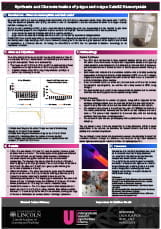by Tobias Whinney //
 In a world where efficiency in energy usage has never been more paramount, nor as well scrutinised on how it impacts our precious planet, new technologies are being discovered at an unprecedented rate. It is essential for developing technology not only to be increasingly energy efficient with exponential capabilities but be safe to use and reduce its environmental impact compared to its predecessors. Nanocrystals (NC’s) offer such a solution.
In a world where efficiency in energy usage has never been more paramount, nor as well scrutinised on how it impacts our precious planet, new technologies are being discovered at an unprecedented rate. It is essential for developing technology not only to be increasingly energy efficient with exponential capabilities but be safe to use and reduce its environmental impact compared to its predecessors. Nanocrystals (NC’s) offer such a solution.
The aim of this project was to test the validity of a method of synthesising CuInS2 NC’s by surfactant driven self-assembly in a nucleation reaction reaching a maximum temperature of approximately 210°C. By varying the amounts of cooper and indium used to grow the NC’s, both p-type and n-type crystals can be produced. They were characterised in terms of their size using dry samples for X-ray diffraction, wet samples for electronic structure using ultraviolet-visible light spectroscopy and their optical properties using photoluminescence spectroscopy.
CuInS2 NC’s have a promising future in uses of photovoltaic cell absorption materials due to possessing: an adjustable band gap; excellent optical properties; relatively low toxicity and an extremely diverse range of potential applications. Through this project, the optimal ratio between copper and indium for crystal composition can be determined.
The project was concluded as a success as crystals of a nanoscale were produced, averaging 101.4nm, which can be easily changed by adjusting the time allowed for the crystals to grow at the maximum temperature. The crystals an encouraging interaction with the spectroscopy methods and producing the expected results for the comparison of the different ratios. The greater the amount of copper, the weaker it interacts with electromagnetic waves towards the ultraviolet end of the visible light spectrum.
The main challenges the project presented included the operation of spectroscopy machines to ensure that reliable results for the spectra were produced. Learning how to use them in order to generate the correct type of analysis for each sample was vital otherwise the results would be heavily skewed and would be unable to be reproduced in further test runs.
Another important issue was to get a consistent increase in temperature in the synthesis of the NC’s. This was resolved by achieving a balance between the heater and constant supply of water and nitrogen to condense the evaporated solution to avoid losing the chemical ratio.
Invaluable techniques for how to use very precise laboratory equipment such as micrometric pipettes were developed as all NC’s are treated as potentially hazardous. Avoiding skin contact or spilling and losing the samples was of the upmost importance due to the lengthy amount of time taken to synthesise, clean and dry the crystals. Therefore, it is critical to take great care when handling NC’s in solid and liquid forms.
Collaborating with my supervisor and working in a professional laboratory over this project has been a great pleasure. With further study and employment in the not too distant future, this will prove to be an indispensable experience.
*To view Tobias project poster, please click on the thumbnail below:

